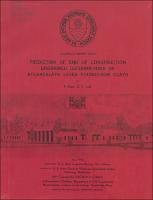Please use this identifier to cite or link to this item:
https://hdl.handle.net/11681/20565| Title: | Prediction of end of construction undrained deformations of Atchafalaya levee foundation clays |
| Authors: | United States. Army. Corps of Engineers. New Orleans District Massachusetts Institute of Technology. Department of Civil Engineering Ladd, Charles C. (Charles Cushing) Foott, Roger |
| Keywords: | Atchafalaya Levee System Louisiana Clays Embankment foundations Finite element method Levee construction Mathematical models Numerical models Soil properties Soil stresses Soil mechanics Levees Design Construction |
| Publisher: | U.S. Army Engineer Waterways Experiment Station. Engineer Research and Development Center (U.S.) |
| Description: | Contract Report Abstract: Levee construction in south-central Louisiana has proven to be very time consuming and expensive because of excessive movements within the soft, highly plastic, thick deposits of the foundation soils. Field measurements from three well instrumented test sections constructed along the· East Atchafalaya Basin Protection Levee (EABPL) have led to the belief that undrained shear strains and long term lateral creep deformations are major factors contributing to the very large settlements of the levees. This report presents the results of finite element predictions of the end of construction lateral deformations on the floodwayside of the EABPL Test Sections II and III. The M.I.T. computer program used for the analyses, which realistically modeled the actual sequence of construction, requires input of the following soil parameters for the foundation soils: (1.) The initial vertical and horizontal stresses. (2.) The undrained shear strength as a function of the orientation of the major principal stress at failure. (3.) A bilinear stress-strain relationship, and particularly the undrained shear modulus prior to yielding. The first step in selection of the soil parameters was a thorough investigation of the stress history of the foundation soils, and especially the in situ maximum past pressure. This study included a detailed consideration of the geology of the area, values of maximum past pressure determined from oedometer tests, the results of field vane tests, and variations in water content and plasticity with depth. A principal conclusion from this work, which proved to be very significant, was the discovery of a highly precompressed zone below El. -45ft. The stress-strain-undrained strength properties of the foundation clay were investigated via a program of consolidated-undrained triaxial, plane strain, and direct-simple shear tests performed on samples K𝚘 consolidated beyond the in situ stresses. The resulting data were normalized and plotted versus overconsolidation ratio and/or shear stress level. The normalized soil parameters, combined with the stress history developed for the foundation clay and a knowledge of zones of highly stressed soil, were then used to select the soil properties required for the analyses. A significant finding was the fact that the Atchafalaya clays have an unusually low shear modulus at stress levels approaching failure. Only one set of predictions were made for each of the test sections. The results, presented in Chapter 8, showed good to excellent agreement between the predicted pattern of lateral deformations and the measured field performance. Most significantly, the computer analyses predicted that the largest shear strains would occur ·in the zone between about El. -45 and -20 ft. It was concluded that the computer model and soil parameters that were developed represent a major advance in understanding the fundamental nature of the long term lateral deformations that have proven so detrimental to the performance of the levees. |
| Rights: | Approved for public release; distribution is unlimited. |
| URI: | http://hdl.handle.net/11681/20565 |
| Appears in Collections: | Contract Report |
Files in This Item:
| File | Description | Size | Format | |
|---|---|---|---|---|
| CR-S-72-3.pdf | 10.49 MB | Adobe PDF |  View/Open |